Child themes are one of those WordPress terms that get thrown around a lot and leave beginners confused. You might have even heard of them and decided to skip creating them because of how complicated they seem.
We get that. But in our experience, child themes can save you a ton of headaches down the road. They protect your precious customizations, let you experiment without breaking your site, and make updating your theme a breeze.
If you’re interested, we have broken down how a child theme works, how to customize it, and how to make changes to it in this beginner-friendly guide.
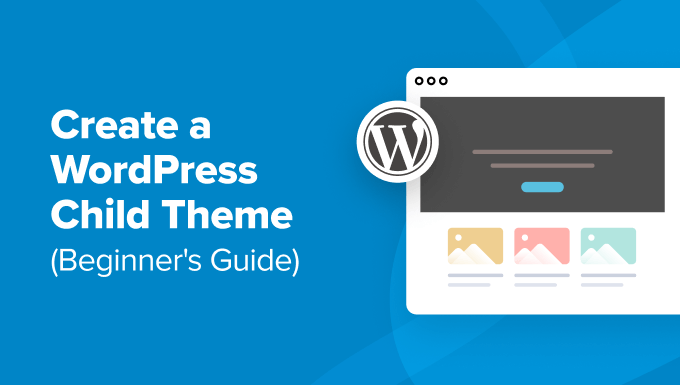
How Does a Child Theme Work, and Why Do You Need It?
A child theme inherits all the features, functions, and styles of another WordPress theme. When you create a child theme, the original theme is called the parent theme.
The inheritance includes the parent theme’s style.css file, which defines the theme’s main style. The child theme can override or extend its inherited properties by adding its own files or by modifying the existing ones.
While it is possible to customize your WordPress theme without installing a child theme, there are several reasons why you may need one anyway:
- Child themes protect your customizations during theme updates, keeping them safe from being overwritten. If you modify the parent theme directly, then those tweaks might vanish when you update.
- Child themes let you safely try out new designs or features without messing up the site’s original theme, similar to a staging environment.
- If you know how to code, then child themes can make the development process more efficient. A child theme’s files are much simpler than a parent theme’s. You can focus on modifying only the parts of the parent theme that you want to change or expand on.
What to Do Before Creating a WordPress Child Theme
We’ve seen lots of WordPress users excited to dive into the technical stuff, only to get discouraged when errors pop up. We get it. That’s why it’s important to know what you are getting into before creating a child theme.
Here are some things we recommend you do first before continuing with this step-by-step guide:
- Be aware that you will be working with code. At the very least, you will need a basic understanding of HTML, CSS, PHP, and, optionally, JavaScript to understand what changes you need to make. You can read more about this in the WordPress theme handbook.
- Choose a parent theme that has your desired website design and features. If possible, find one where you only need to make a few changes. You can follow our checklist of things to do before changing WordPress themes if needed.
- Use a local site or a staging site for theme development. You don’t want to create unintentional errors on your live site.
- Back up your website first. We recommend using a backup plugin like Duplicator if this is your first time.
There are several ways to create a child theme out of your existing theme. One is with manual code, while others require a plugin, which is a lot more beginner-friendly.
The first method may seem intimidating if you lack technical experience. That said, even if you choose one of the plugin methods, we still recommend reading through the manual method to familiarize yourself with the process and the files involved.
Pro Tip: Want to customize your theme without creating a child theme? Use WPCode to safely enable new features with custom code snippets without breaking your website.
With all that in mind, let’s get to how to create a child theme in WordPress. You can jump to the method you prefer using the links below:
- Method 1: Creating a Child WordPress Theme Manually
- Method 2: Creating a Child Classic Theme With a Plugin
- Method 3: Creating a Child Block Theme With a Plugin
- Bonus Tip: Find Out If Your Theme Has a Child Theme Generator
- How to Customize Your Classic Child Theme
- How to Customize Your Block Child Theme
- How to Edit a Child Theme's Template Files
- How to Add New Functionality to Your Child Theme
- How to Troubleshoot Your WordPress Child Theme
Method 1: Creating a Child WordPress Theme Manually
First, you need to open /wp-content/themes/ in your WordPress installation folder.
You can do this by using your WordPress hosting’s file manager or an FTP client. We find the first option to be much easier, so we will use that.
If you are a Bluehost client, then you can log in to your hosting account dashboard and navigate to the ‘Websites’ tab. After that, click ‘Settings.’
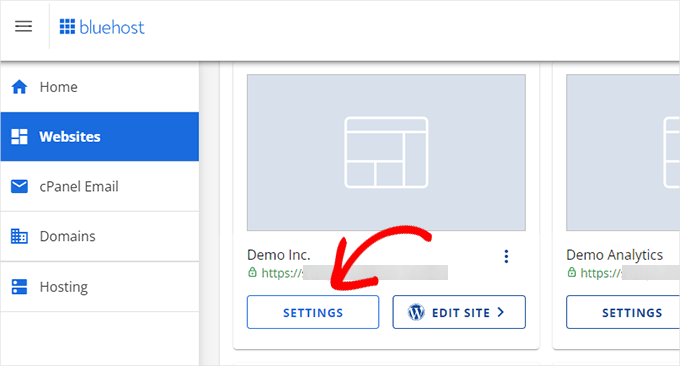
In the Overview tab, scroll down to the ‘Quick Links’ section.
Then, select ‘File Manager.’
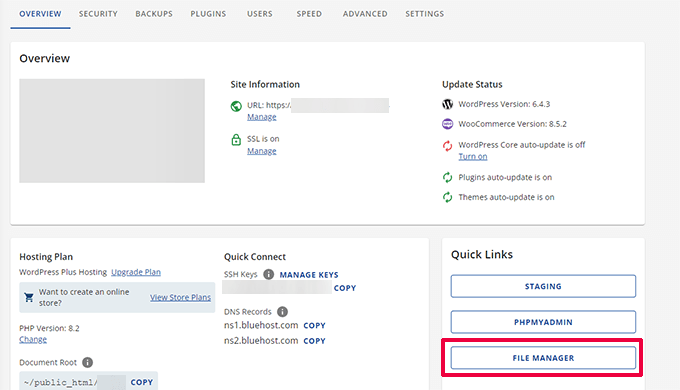
At this stage, you need to go to your website’s public_html folder and open the /wp-content/themes/ path.
Here, just click the ‘+ Folder’ button in the top left corner to create a new folder for your child theme.
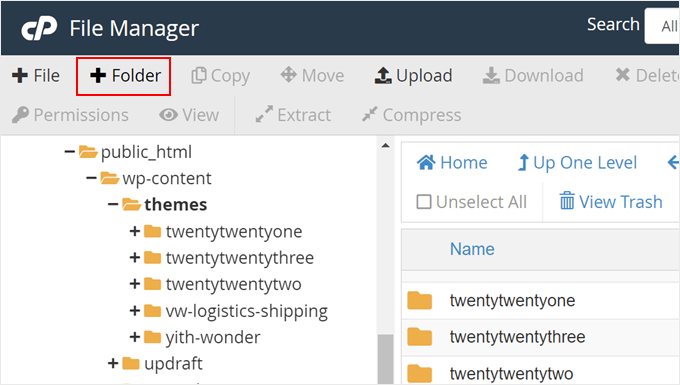
You can name the folder anything you want.
For this tutorial, we will just use the folder name twentytwentyone-child as we will use Twenty Twenty-One as our parent theme. Once done, just click ‘Create New Folder.’
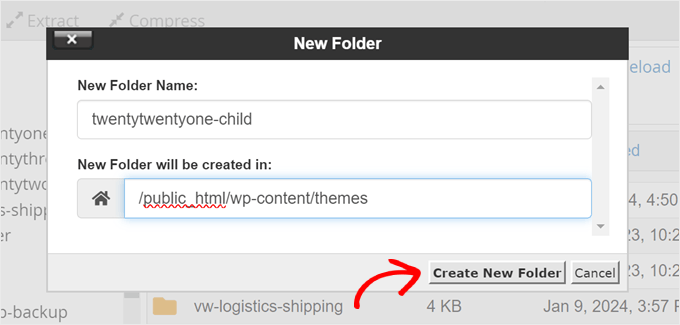
Next, you must open the folder you just made and click ‘+ File’ to create the first file for your child theme.
If you use an FTP client, then you can use a text editor like Notepad and upload the file later.
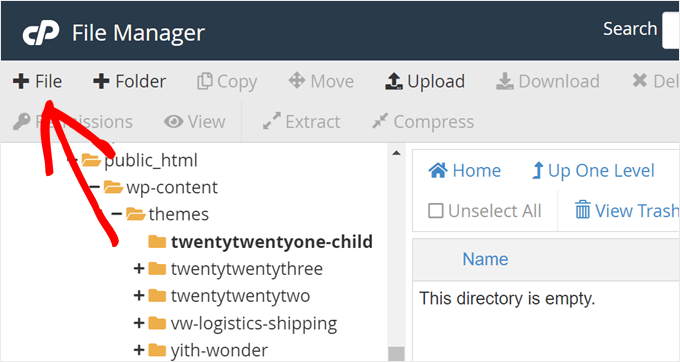
Go ahead and name this file ‘style.css’ ,as it is your child’s main stylesheet and will contain information about the child theme.
Then, click ‘Create New File.’
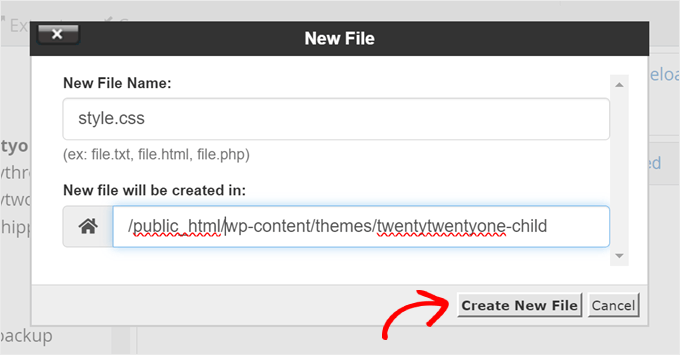
Now, just right-click on the style.css file.
After that, click ‘Edit’ to open a new tab like in the screenshot below.
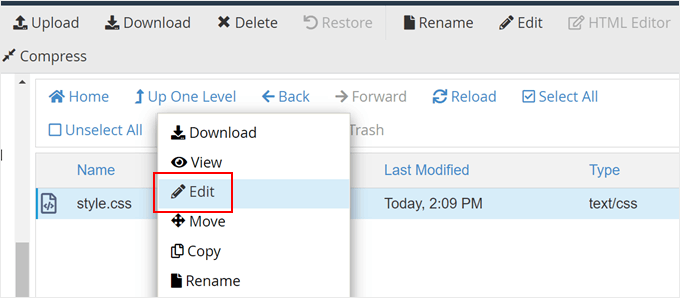
In this new tab, you can paste the following text and adjust it based on your needs:
/*
Theme Name: Twenty Twenty-One Child
Theme URI: https://wordpress.org/themes/twentytwentyone/
Description: Twenty Twenty-One child theme
Author: WordPress.org
Author URI: https://wordpress.org/
Template: twentytwentyone
Version: 1.0.0
Text Domain: twentytwentyonechild
*/
Once done, just click ‘Save Changes.’

The next thing you need to do is create a second file and name it functions.php. This file will import or enqueue the stylesheets from the parent theme’s files.
Once you’ve created the document, add the following wp_enqueue code:
add_action( 'wp_enqueue_scripts', 'my_theme_enqueue_styles' );
function my_theme_enqueue_styles() {
$parenthandle = 'twenty-twenty-one-style'; // This is 'twenty-twenty-one-style' for the Twenty Twenty-one theme.
$theme = wp_get_theme();
wp_enqueue_style( $parenthandle, get_template_directory_uri() . '/style.css',
array(), // if the parent theme code has a dependency, copy it to here
$theme->parent()->get('Version')
);
wp_enqueue_style( 'custom-style', get_stylesheet_uri(),
array( $parenthandle ),
$theme->get('Version') // this only works if you have Version in the style header
);
}
Once done, just save the file like in the previous step.
Note: For this method, we recommend reading the official Child Themes and Including Assets documentation to make sure your child theme’s stylesheets are loaded properly.
You’ve now created a very basic child theme. When you go to Appearance » Themes in your WordPress admin panel, you should see the Twenty Twenty-One Child option.
Click the ‘Activate’ button to start using the child theme on your site.
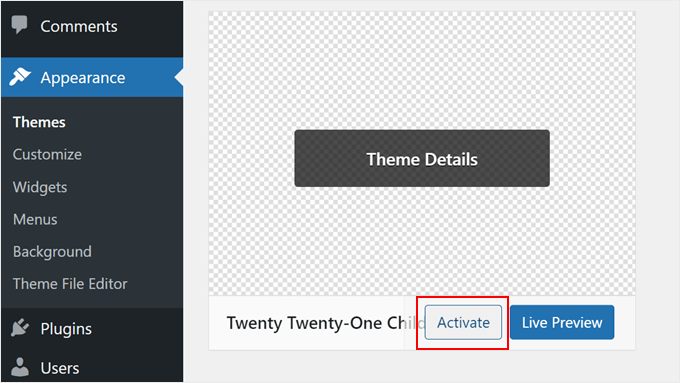
Method 2: Creating a Child Classic Theme With a Plugin
This next method uses the Child Theme Configurator plugin. This easy-to-use WordPress plugin lets you create and customize WordPress child themes quickly without using code, but it only works well with a classic (non-block) theme.
The first thing you need to do is install and activate the WordPress plugin. On activation, you need to navigate to Tools » Child Themes in your WordPress dashboard.
In the Parent/Child tab, you’ll be asked to choose an action. Just select ‘CREATE a new Child Theme’ to get started.
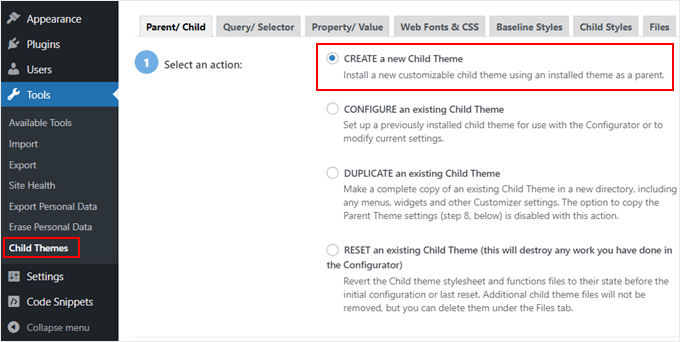
Then, select a parent theme from a dropdown menu. We will select the Hestia theme.
After that, just click the ‘Analyze’ button to make sure the theme is suitable for use as a parent theme.

Next, you will be asked to name the folder the child theme will be saved in. You can use any folder name you want.
Below that, you need to select where to save the new styles: in the primary stylesheet or a separate one.
The primary stylesheet is the default stylesheet that comes with your child theme. When you save new custom styles to this file, you are directly modifying the main styles of your child theme. Every modification will overwrite the original theme’s style.
The separate option allows you to save a new custom style to a separate stylesheet file. This is useful if you want to preserve the original theme’s style and not overwrite it.
For demonstration purposes, we will choose the first option. But as you get more creative with your child theme customizations, you can always repeat this process and select the second option.

Moving down, you have to choose how the parent theme’s stylesheet will be accessed.
We will just go with the default ‘Use the WordPress style queue’ as it will let the plugin determine the appropriate actions automatically.

When you get to step 7, you’ll need to click the button labeled ‘Click to Edit Child Theme Attributes’.
You can then fill in the details of your child theme.
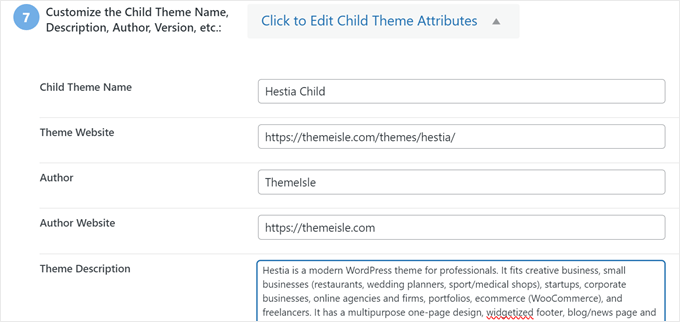
When you create a child theme manually, you will lose the parent theme’s menus and widgets. Child Theme Configurator can copy them from the parent theme to the child theme. Check the box in step 8 if you’d like to do this.
Finally, click the ‘Create New Child Theme’ button to make your new child theme.
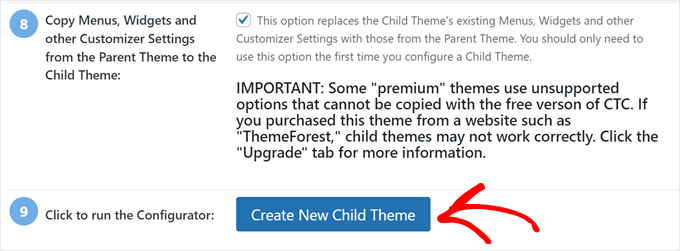
The plugin will create a folder for your child theme and add the style.css and functions.php files you’ll use to customize the theme later.
Before you activate the theme, you should click the link near the top of the screen to preview it and make sure it looks good and doesn’t break your site.
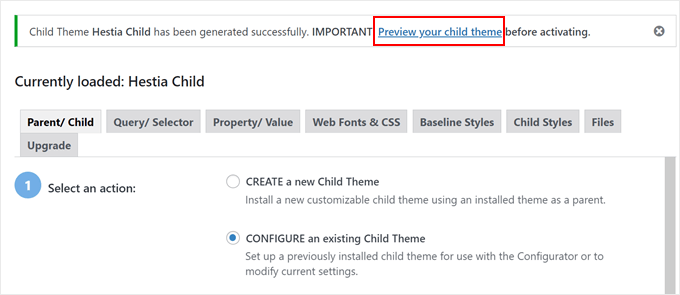
If everything seems to be working, click the ‘Activate & Publish’ button.
Now, your child theme will go live.
At this stage, the child theme will look and behave exactly like the parent theme.
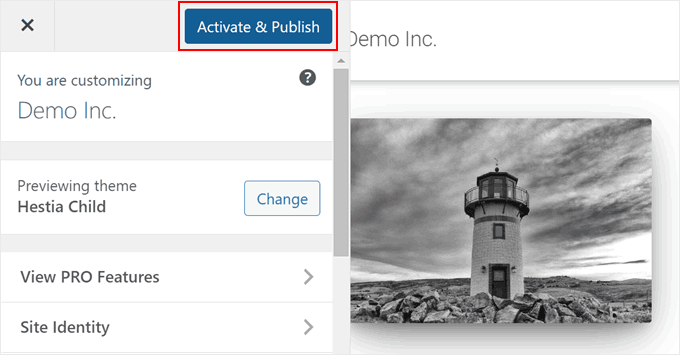
Method 3: Creating a Child Block Theme With a Plugin
If you use a block theme, then WordPress offers an easy way to create a child theme with the Create Block Theme plugin.
First, you will need to install and activate the WordPress plugin. After that, go to Appearance » Create Block Theme.
Here, simply select ‘Create a Child of [current theme name].’
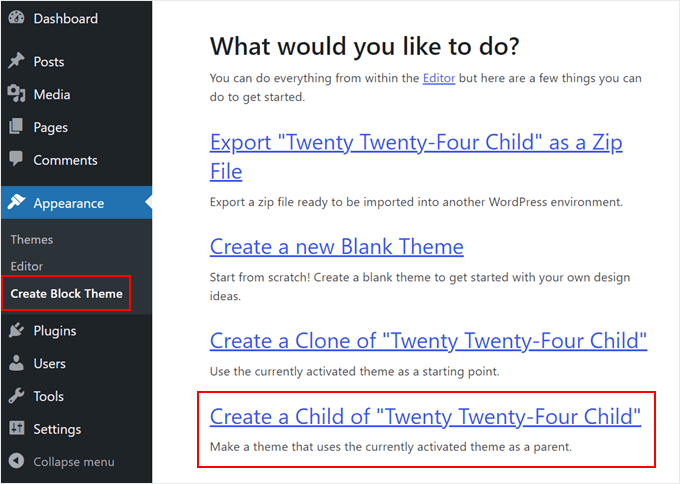
Next, fill out your child theme’s information. We are using Twenty Twenty-Four in this example, so we will name it Twenty Twenty-Four Child.
We also gave a description and author for the child theme. Once done, click on the ‘Create Child Theme’ button.
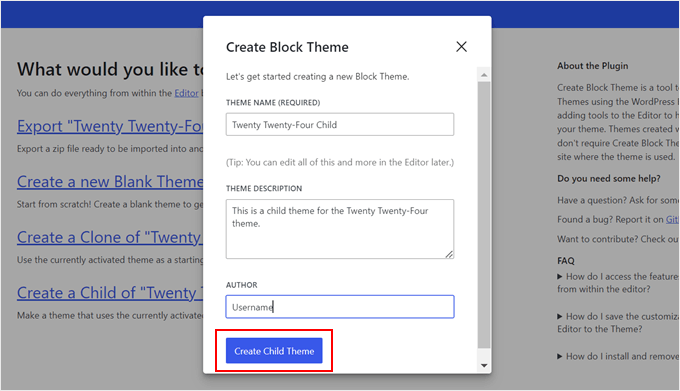
The plugin will now create and install the WordPress theme zip file to your admin area.
Once done, your website will automatically activate this newly created child theme. You can confirm this by going to Appearance » Themes.
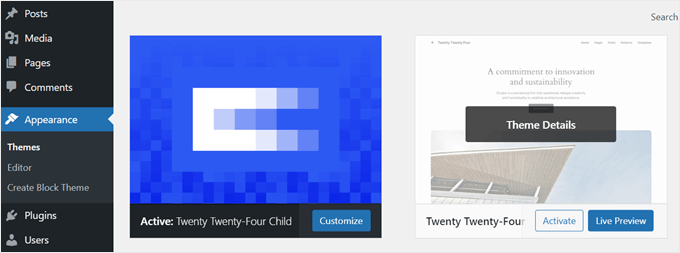
Bonus Tip: Find Out If Your Theme Has a Child Theme Generator
If you are lucky, then your WordPress theme may already have an existing feature to create a child theme.
For example, if you use Astra, then you can go to the Astra Child Theme Generator website. After that, just fill out your child theme name and click the ‘Generate’ button.
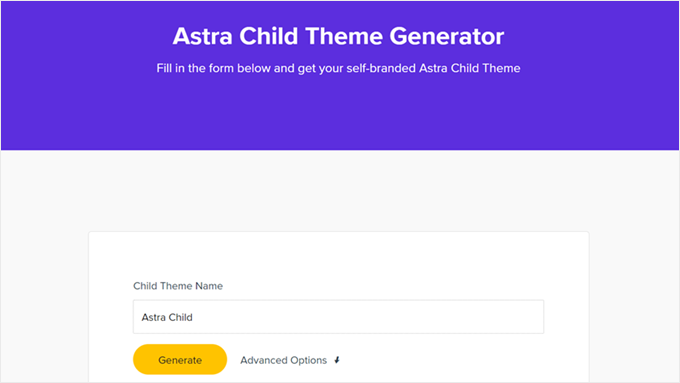
Your browser will then automatically download your child theme to your computer, which you can then install on WordPress yourself.
We also found some other popular WordPress themes that have a child theme generator:
How to Customize Your Classic Child Theme
Note: This section is for classic WordPress theme users. If you use a block theme, then just skip to the next section.
Technically, you can customize your child theme without code by using the Theme Customizer. The changes you make there won’t affect your parent theme. If you are not comfortable with coding yet, then feel free to use the Customizer.
That said, we also recommend customizing the child theme with code.
Besides learning more about WordPress theme development, code customization allows for the changes to be documented within the child theme’s files, making it easier to track them.
Now, the most basic way to customize a child theme is by adding custom CSS to the style.css file. To do that, you need to know what code you need to customize.
You can simplify the process by copying and modifying the existing code from the parent theme. You can find that code by using the Chrome or Firefox Inspect tool or by copying it directly from the parent theme’s CSS file.
Method 1: Copying Code from the Chrome or Firefox Inspector
The easiest way to discover the CSS code you need to modify is by using the inspector tools that come with Google Chrome and Firefox. These tools allow you to look at the HTML and CSS behind any element of a web page.
You can read more about the inspector tool in our guide on the basics of inspect element: customizing WordPress for DIY users.
When you right-click on your web page and use the inspect element, you will see the HTML and CSS for the page.
As you move your mouse over different HTML lines, the inspector will highlight them in the top window. It will also show you the CSS rules related to the highlighted element, like so:
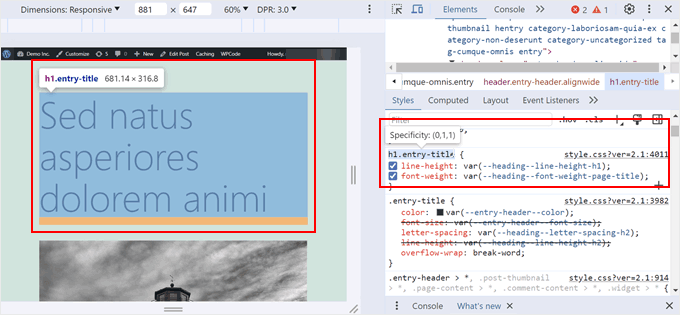
You can try editing the CSS right there to see how it would look. For example, let’s try changing the background color of the theme’s body to #fdf8ef. Find the line of code that says body { and inside it, the code that says color: .
Just click the color picker icon next to color: and paste the HEX code into the appropriate field, like so:
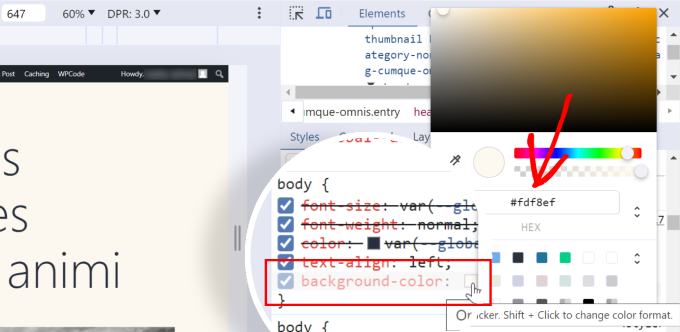
Now, you know how to change the background color using CSS. To make the changes permanent, you can open your style.css file in the child theme directory (using the file manager or FTP).
Then, paste the following code below the child theme information, like so:
/*
Theme Name: Twenty Twenty-One Child
Theme URI: https://wordpress.org/themes/twentytwentyone/
Description: Twenty Twenty-One child theme
Author: WordPress.org
Author URI: https://wordpress.org/
Template: twentytwentyone
Version: 1.0.0
Text Domain: twentytwentyonechild
*/
body {
background-color: #fdf8ef
}
Here is what it will look like if you go to the WordPress admin and open Appearance » Theme File Editor:
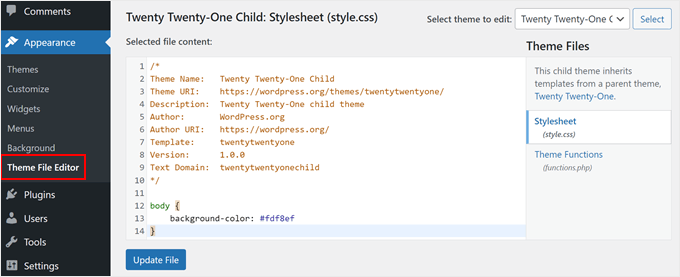
If you are a beginner and want to make other changes, then we recommend getting familiar with HTML and CSS so that you know exactly what element each code is referring to. There are many HTML and CSS cheat sheets online that you can refer to.
Here is the complete stylesheet that we have created for the child theme. Feel free to experiment and modify it:
/*
Theme Name: Twenty Twenty-One Child
Theme URI: https://wordpress.org/themes/twentytwentyone/
Description: Twenty Twenty-One child theme
Author: WordPress.org
Author URI: https://wordpress.org/
Template: twentytwentyone
Version: 1.0.0
Text Domain: twentytwentyonechild
*/
.site-title {
color: #7d7b77;
}
.site-description {
color: #aba8a2;
}
body {
background-color: #fdf8ef;
color: #7d7b77;
}
.entry-footer {
color: #aba8a2;
}
.entry-title {
color: #aba8a2;
font-weight: bold;
}
.widget-area {
color: #7d7b77;
}
Method 2: Copying Code From the Parent Theme’s style.css File
Maybe there are a lot of things in your child theme that you want to customize. In that case, it may be quicker to copy some code directly from the parent theme’s style.css file, paste it into your child theme’s CSS file, and then modify it.
The tricky part is that a theme’s stylesheet file can look really long and overwhelming to beginners. However, once you understand the basics, it’s actually not that hard.
Let’s use a real example from the Twenty Twenty-One parent theme’s stylesheet. You need to navigate to /wp-content/themes/twentytwentyone in your WordPress installation folder and then open the style.css file in your file manager, FTP, or Theme File Editor.
You will see the following lines of code:
:root {
/* Colors */
--global--color-black: #000;
--global--color-dark-gray: #28303d;
--global--color-gray: #39414d;
--global--color-light-gray: #f0f0f0;
--global--color-green: #d1e4dd;
--global--color-blue: #d1dfe4;
--global--color-purple: #d1d1e4;
--global--color-red: #e4d1d1;
--global--color-orange: #e4dad1;
--global--color-yellow: #eeeadd;
--global--color-white: #fff;
--global--color-white-50: rgba(255, 255, 255, 0.5);
--global--color-white-90: rgba(255, 255, 255, 0.9);
--global--color-primary: var(--global--color-dark-gray); /* Body text color, site title, footer text color. */
--global--color-secondary: var(--global--color-gray); /* Headings */
--global--color-primary-hover: var(--global--color-primary);
--global--color-background: var(--global--color-green); /* Mint, default body background */
--global--color-border: var(--global--color-primary); /* Used for borders (separators) */
}
Lines 3 to 15 control the type of colors (like yellow, green, purple) that the entire theme will use in their specific HEX codes. And then, for lines like ‘global-color-primary’ or ‘global-color-secondary,’ that means those are the primary and secondary colors of that theme.
You can copy these lines of code to your child theme’s stylesheet and then change the HEX codes to create your perfect color scheme.
As you scroll down in the parent theme’s stylesheet, you will notice that other variables may have these color variables, too, like here:
/* Buttons */
--button--color-text: var(--global--color-background);
This basically means all button texts will use the same color as declared in --global--color-background:, which is mint green (--global--color-green: #d1e4dd). If you change the HEX in --global--color-green:, then the button text will look different, too.
Note: If you use the Twenty Twenty-One child theme and do not see any changes, then you may need to update the ‘Version’ part of the theme file information (for example, from 1.0 to 2.0) every time you update the style.css file.
You can also follow these tutorials to experiment with your child theme customizations:
- How to Change the Text Color in WordPress
- How to Change Your WordPress Logo Size (Works With Any Theme)
- How to Customize Blockquotes Style in WordPress Themes
- WordPress Body Class 101: Tips and Tricks for Theme Designers
- How to Add a Parallax Effect to Any WordPress Theme
How to Customize Your Block Child Theme
If you use a child block theme, then most of your customizations will be done to your theme.json file, not style.css.
However, during our testing, we found the process to be complicated. Unlike classic child themes, there’s a bigger knowledge gap you need to fill in (especially about JSON and how CSS is handled there) if you are new to WordPress theme development.
That said, we found a much easier alternative using the Create Block Theme plugin. This tool can record any changes made in the WordPress Full Site Editor in your child theme.json’s file. So, you won’t have to touch any code at all because the plugin will take care of it for you.
Let’s show you an example. First, open the WordPress Full Site Editor by going to Appearance » Editor.
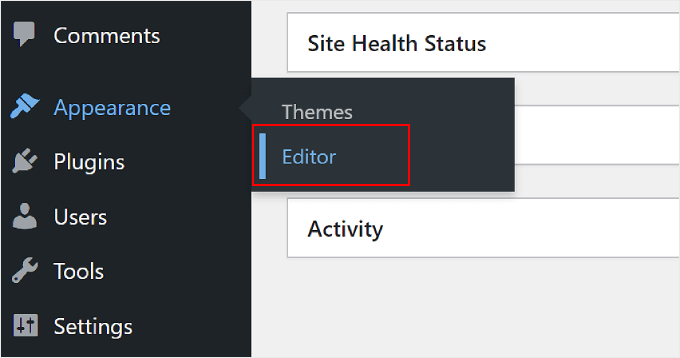
You will see several menus to choose from.
Here, just select ‘Styles.’
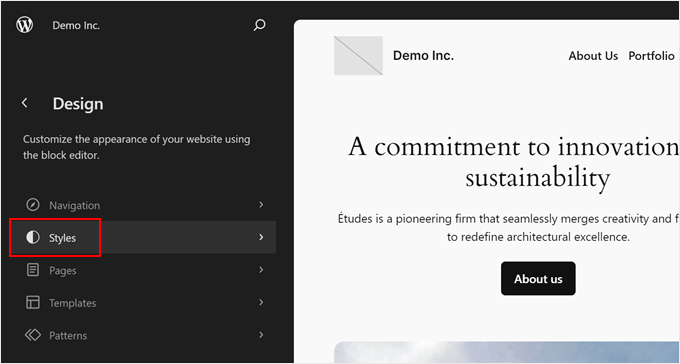
On the next page, you will see several built-in style combinations to choose from.
For our purpose, you can simply skip all of that and just click the pencil icon.
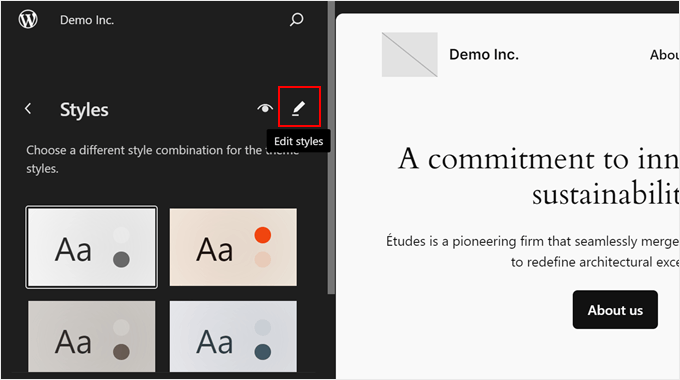
Now, let’s try changing some parts of your child theme, like the fonts.
For this example, go ahead and click ‘Typography’ in the right sidebar.
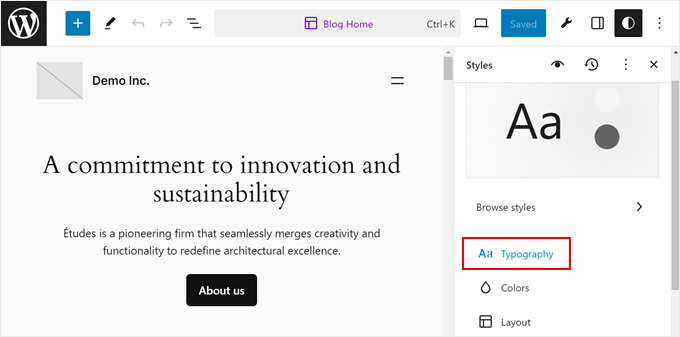
Next, you will see some options to change the theme’s global fonts for text, links, headings, captions, and buttons.
Let’s click ‘Headings’ for the sake of demonstration.
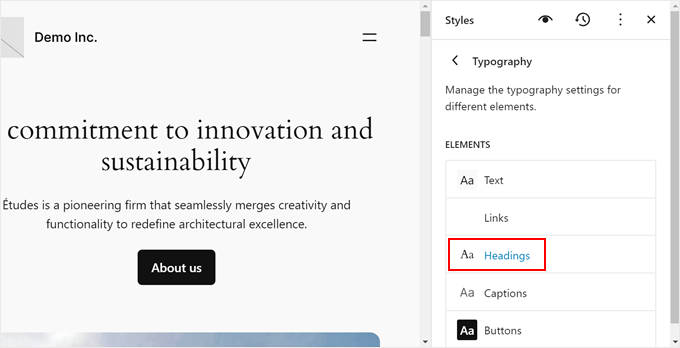
In the Font dropdown menu, change the original pick to any font that’s available.
Feel free to change the appearance, line height, letter spacing, and letter casing if needed.
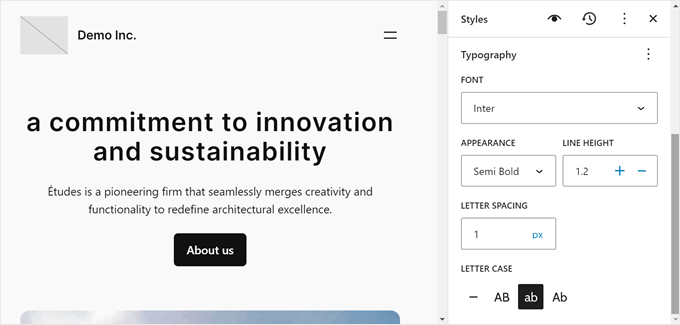
Once you are done, just click ‘Save.’ After that, you can click the Create Block Theme button (the wrench icon) next to ‘Save.’
Then, click ‘Save Changes to Theme.’
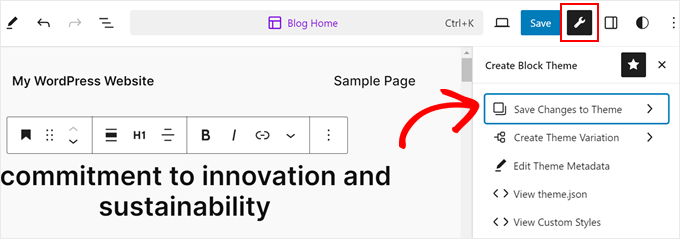
Next, go ahead and select what changes to save to the child theme.
Examples include fonts, custom styles, template changes, and more.
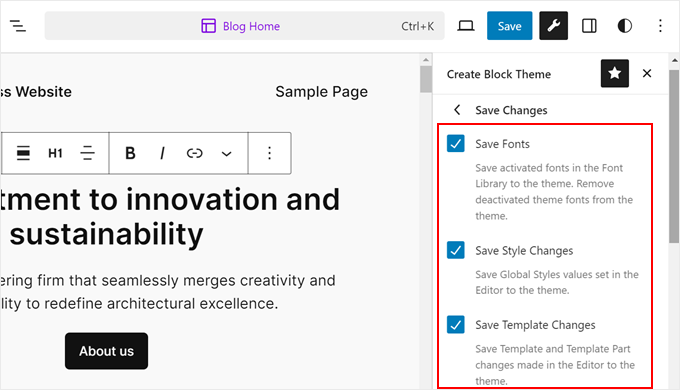
Once done, just scroll all the way down the sidebar.
Then, click ‘Save Changes.’
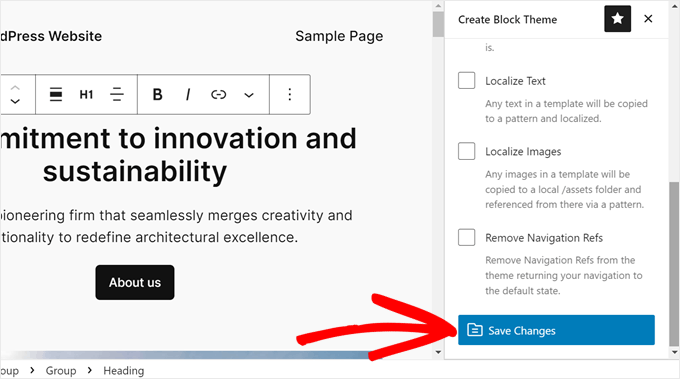
Now, let’s view your theme.json file so that you can see the changes reflected in the code.
To do this, click on the Create Block Theme button again and select ‘View theme.json.’
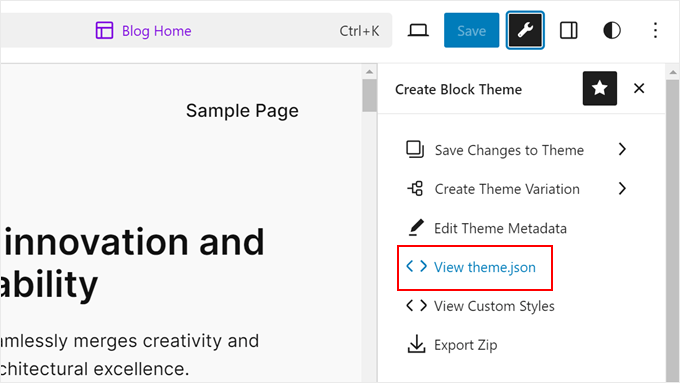
After clicking on it, you will see that the file includes some new code additions.
In our case, the file includes code that indicates that heading tags will use the Inter font with semi-bold appearance, 1.2 line height, 1 pixel line spacing, and in lowercase.
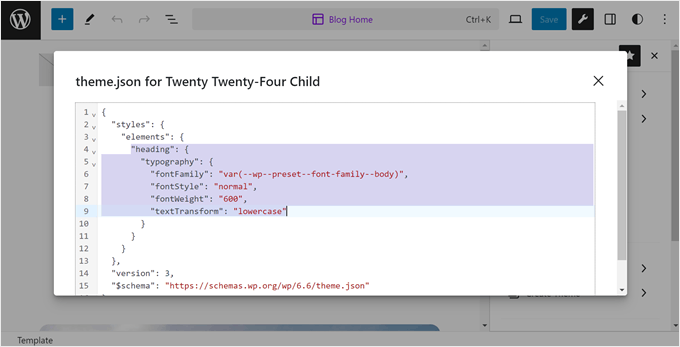
So, whenever you edit your child block theme, make sure to click the wrench icon and save your changes so that they are well-documented.
How to Edit a Child Theme’s Template Files
Most WordPress themes have templates, which are theme files that control the design and layout of a specific area inside a theme. For example, the footer section is usually handled by the footer.php file, and the header is handled by the header.php file.
Each WordPress theme also has a different layout. For example, the Twenty Twenty-One theme has a header, content loop, footer widget area, and footer.
If you want to modify a template, then you have to find the file in the parent theme folder and copy it to the child theme folder. After that, you should open the file and make the modifications you want.
For example, if you use Bluehost and your parent theme is Twenty Twenty-One, then you can go to /wp-content/themes/twentytwentyone in your file manager. Then, right-click on a template file like footer.php and select ‘Copy.’
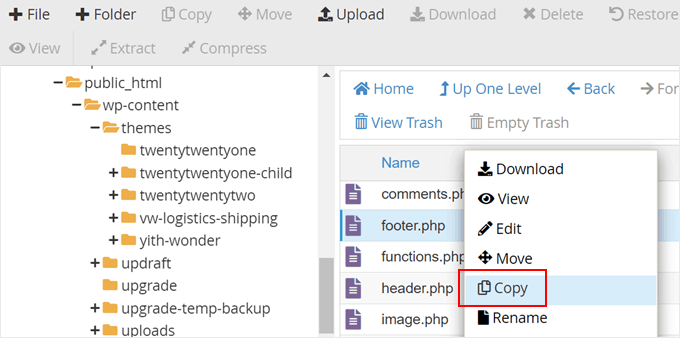
After that, enter the file path of your child theme.
Once you are done, simply click ‘Copy Files.’
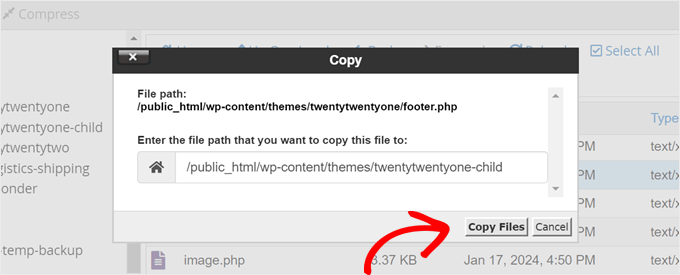
You will then be redirected to the file path.
To edit the footer.php file, just right-click on it and select ‘Edit.’
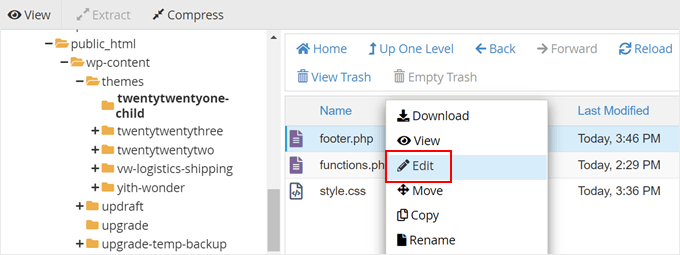
As an example, we will remove the ‘Proudly powered by WordPress’ link from the footer area and add a copyright notice there.
To do that, you should delete everything between the <div class= "powered-by"> tags:
<div class="powered-by">
<?php
printf(
/* translators: %s: WordPress. */
esc_html__( 'Proudly powered by %s.', 'twentytwentyone' ),
'<a href="' . esc_url( __( 'https://wordpress.org/', 'twentytwentyone' ) ) . '">WordPress</a>'
);
?>
</div><!-- .powered-by -->
Then you need to paste in the code you find below those tags in the example below:
<div class="powered-by">
<p>© Copyright <?php echo date("Y"); ?>. All rights reserved.</p>
</div><!-- .powered-by -->
Here’s what you should now have in the text editor:
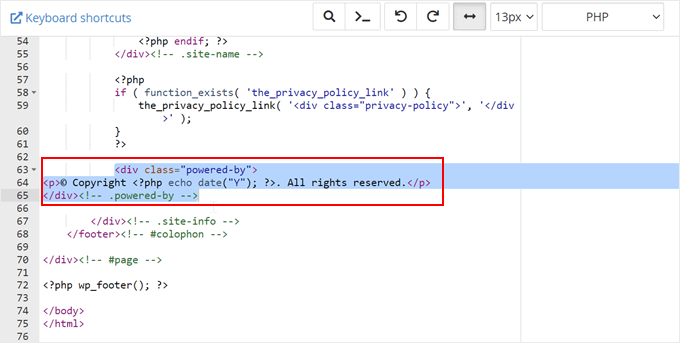
Go ahead and save the file to make the changes official.
After that, visit your website to see the new copyright notice.
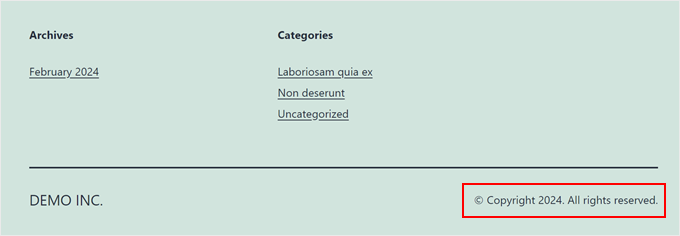
How to Add New Functionality to Your Child Theme
The functions.php file in a theme uses PHP code to add features or change default features on a WordPress site. It acts like a plugin for your WordPress site that’s automatically activated with your current theme.
You’ll find many WordPress tutorials that ask you to copy and paste code snippets into functions.php. But if you add your modifications to the parent theme, then they will be overwritten whenever you install a new update to the theme.
That’s why we recommend using a child theme when adding custom code snippets. In this tutorial, we will add a new widget area to our theme.
We can do that by adding this code snippet to our child theme’s functions.php file. To make the process even safer, we recommend using the WPCode plugin so that you don’t edit the functions.php file directly, reducing the risk of errors.
You can read our guide on how to add custom code snippets for more information.
Here is the code you need to add your functions.php file:
// Register Sidebars
function custom_sidebars() {
$args = array(
'id' => 'custom_sidebar',
'name' => __( 'Custom Widget Area', 'text_domain' ),
'description' => __( 'A custom widget area', 'text_domain' ),
'before_title' => '<h3 class="widget-title">',
'after_title' => '</h3>',
'before_widget' => '<aside id="%1$s" class="widget %2$s">',
'after_widget' => '</aside>',
);
register_sidebar( $args );
}
add_action( 'widgets_init', 'custom_sidebars' );
Once you save the file, you can visit the Appearance » Widgets page of your WordPress dashboard.
Here, you will see your new custom widget area that you can add widgets to.
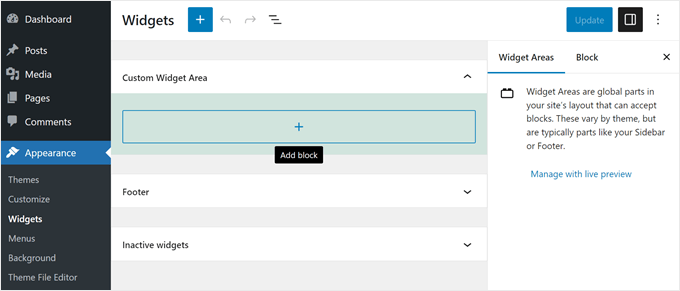
There are plenty of other features you can add to your theme using custom code snippets. Check out these extremely useful tricks for the WordPress functions.php file and useful WordPress code snippets for beginners.
How to Troubleshoot Your WordPress Child Theme
If you’ve never created a child theme before, then there’s a good chance you’ll make some mistakes, and that’s normal. This is why we recommend using a backup plugin, creating a local site or staging environment, and using dummy content for your demo site.
All that being said, don’t give up too quickly. The WordPress community is very resourceful, so whatever problem you are having, a solution probably already exists.
For starters, you can check out our most common WordPress errors to find a solution.
The most common errors you’ll probably see are syntax errors caused by something you missed in the code. You’ll find help in solving these issues in our quick guide on how to find and fix the syntax error in WordPress.
Additionally, you can always start again if something goes very wrong. For example, if you accidentally deleted something that your parent theme required, then you can simply delete the file from your child theme and start over.
We hope this article helped you learn how to create a WordPress child theme. You may also want to check out our ultimate guide on how to test your WordPress theme against the latest standards and our comparison piece on free vs premium WordPress themes.
If you liked this article, then please subscribe to our YouTube Channel for WordPress video tutorials. You can also find us on Twitter and Facebook.





Mrteesurez
This article is incredibly insightful, especially for those of us who are just beginning our WordPress journey. I remember when I first started, I underestimated the importance of using a child theme and ended up losing all my customizations after a theme update. Learning the hard way made me appreciate the value of a child theme in preserving changes. Thank you for highlighting what to do before creating one—this guide will surely save many beginners from similar frustrations!
Oyatogun Oluwaseun Samuel
I love the flexibility offered by child theme in that when there’s an update of the parent theme, the changes made in the child theme are maintained. Also I also love to manually create child theme as I believe doing it that way may expose me to mistakes which will in turn increase my understanding and expertise. We learn when we make mistakes.
Mrteesurez
I completely agree with you! The flexibility that child themes provide is a game changer, especially when it comes to maintaining customizations through parent theme updates. I’ve also enjoyed manually creating child themes for the same reason. While it can be a bit daunting at first, I’ve found that diving into the code not only enhances my understanding but also boosts my confidence as a developer.
I remember when I first started working with child themes, I made a few mistakes along the way—like forgetting to enqueue styles correctly or messing up the functions.php file. Each mistake was a valuable learning opportunity, helping me to better grasp how WordPress themes work. Plus, knowing that my customizations are safe during updates gives me peace of mind. It’s definitely a worthwhile skill to develop! Thanks for sharing your thoughts; it’s great to connect with others who value hands-on learning.
Chris
I never really gave child themes much thought, thinking they weren’t necessary. Before reading this article, I didn’t realize that customized functions are removed from the functions.php file when the theme is updated. For me, a child theme is a must if I use a theme from WordPress theme repository. Thanks for this informative article!
Dayo Olobayo
Great point about child themes. There’s also another option to consider though… Some premium themes offer customization panels that avoid the need for code edits altogether. However, child themes gives more flexibility in the long run especially if you’re comfortable with a little code.
Mrteesurez
The same thing happened to me when I first started, I didn’t give child theme any consideration before, I later found how helpful it is especially when adding more customization to the free theme that has frequent updates. Child theme file is loaded first before parent theme making it possible to preserve the customization added.
Hajjalah
Thanks for this comprehensive guide. I would like to create a child theme using the plugin method but still have some not sure about some issues.
Will the codes in the WPCode plugin take effect on the child theme? If the parent theme is updated but the child theme is not updated, Can’t they conflict to cause an error?
WPBeginner Support
Yes the code in WPCode will appear on your child theme and if you update the parent theme there is a chance of conflict but it is not a guarantee.
Admin
Mrteesurez
Good question Mr. Hajjalah.
I had the same concerns when I first started creating child themes. Using the WPCode plugin, the code should apply to both the parent and child themes, as long as it’s placed correctly. However, if the parent theme updates and the child theme doesn’t, there can be conflict. I once had a layout issue due to this, but updating and testing the updates on a staging site helped me avoid errors.
Jiří Vaněk
A child theme is always the first thing I create on a newly installed site. Although I try to use WP Code a lot and avoid problems, but the child theme is an absolutely brilliant thing when updating a template and can save a lot of trouble with lost code that disappears from the main template after an update.
Asad
Sir, what should I write in function.php to call the Parent theme?
WPBeginner Support
You would want to use the code from our article below the text /* enqueue scripts and style from parent theme */
Admin
Yogesh Sambare
Hi, Team wpbeginner,
Thanks for this awesome guide, now I think I’m able to make my themes child theme, and it’s really helpful for me .
WPBeginner Support
Glad you found our guide helpful!
Admin
Ricardo
The line:
“wp_get_theme()->get(‘Version’) )”
Should be:
“wp_get_theme()->get(‘Version’) )”
cheers!
WPBeginner Support
While our comments automatically changed that in your message, we see the issue, thank you for letting us know
Admin
Rubb
Can I delete the plugin after I create the child theme?
WPBeginner Support
Currently, you can do that with the plugin
Admin
Eitan
You need to add quotation marks to the Y = (“Y”) at the echo date, or you’ll get an error. – echo date(“Y”)
WPBeginner Support
Thank you for pointing out the typo
Admin
Bomo
So now that we have created a child theme, how do we update the parent theme when the child theme is activated?
WPBeginner Support
You would update the parent theme as you normally would. For safety, you may want to create a backup before you update the parent theme in case there is a conflict somewhere.
Admin
RYAD
But do we have to activate the parent theme before we update and them desactivate it and reactivate the child theme ?
WPBeginner Support
No, you can update the theme without it being active
Mahesh Yadav
One thing I want to know, if we make a child theme then we have 2 CSS files to load one parent theme CSS and second child them CSS. Wouldn’t it increase the site load time and It added one more CSS to load?
WPBeginner Support
While the load time would technically increase, it shouldn’t be by a noticeable amount.
Admin
Nadia Shaheen
Great work!
stay blessed and keep sharing awesome content.
WPBeginner Support
Thank you, glad you liked our content
Admin
Fahad
Great Work !
This site is super helpful
Keep it up !!
WPBeginner Support
Thank you, glad our article was helpful
Admin
Daniel Waduka
I am just starting to use child themes, and this article has been of so much help to me.
Thanks so much.
WPBeginner Support
Glad our guide could be helpful
Admin
Marcos Flores
Hi! i’ve been reading this article and it works! but i also read wordpress documentation about this and they say this
“Note that the previous method was to import the parent theme stylesheet using @import: this is no longer best practice, as it increases the amount of time it takes style sheets to load. The correct method of enqueuing the parent theme stylesheet is to add a wp_enqueue_scripts action and use wp_enqueue_style() in your child theme’s functions.php ”
Should i use both method? or if i user the function.php i dont need to write import function inside style.css (located in my child-theme folder)
Khema
Your instructions are missing a step with the functions.php creation. It should mention that needs to wrap the whole file. In this case I didn’t want to add the example you used and to another piece of code from the article you linked to. Naturally those codes didn’t include the php tag.
Thanks for the article. It’s very very helpful.
rReons
So question. I was using my wordpress theme without any child theme and was doing all the changes in to it. I have created a child theme thanks to your guide and I’m using that now as the website theme.
My question is both themes have the same modifications changes. If I update the main theme from now on, will the changes affect the child theme also?
balu
He! wpbeginner. Wordpress official site saying this. You need to update the post. Thank You!
Note that the previous method was to import the parent theme stylesheet using @import: this is no longer best practice, as it increases the amount of time it takes style sheets to load. The correct method of enqueuing the parent theme stylesheet is to add a wp_enqueue_scripts action and use wp_enqueue_style() in your child theme’s functions.php. You will therefore need to create a functions.php in your child theme directory. The first line of your child theme’s functions.php will be an opening PHP tag (<?php), after which you can enqueue your parent and child theme stylesheets. The following example function will only work if your Parent Theme uses only one main style.css to hold all of the css. If your child theme has more than one .css file (eg. ie.css, style.css, main.css) then you will have to make sure to maintain all of the Parent Theme dependencies.
Pat
Great info…you made it to my save list!! Thanks!
Alfonso de Garay
I have a Child theme with the theme latest version installed in my site. WP version 4.7.5. Received a notice that says WP version is available please update now.
1. Do I have to backup my site again before updating?
2. Do I have to create another Child theme using Child version 1 one?
2. How can I change the Name, email and URL to Chile version 1
WPBeginner Support
Hi Alfonso,
WordPress updates normally do not affect your themes so you do not need to create another child theme. You should always backup your website before updating WordPress.
Admin
Lisa Bruce
Hi, I can see that this video/post is a few years old, so I’m a little late to the party, but I have a questions I was hoping you could help me with.
I am a relatively new to WP and just came to realize the importance of child themes. I have been working on developing a site for a friend and have made several changes to the theme that I am using. I found a bug in the theme and contacted the theme developer and they said that the bug had been fixed in a recent update.
If I install the update I believe I will loose all my customizations. Is it too late to create a child them? Is it possible to do it now and then install the update? I prefer not to have to start from scratch.
WPBeginner Support
Hi Lisa,
If you know what changes you made and to which files, then first download a backup of your existing theme to your computer. After that, install the updated version. You can now create a child theme and then copy and paste the code from your customized version to the child theme.
Admin
Nell Yang
Thank you for this helpful post. I have always been looking for a video to show me how exactly should I use child theme. It is quite time consuming that each time after I updated my theme, all my styles just went away. It is frustrating to do everything over again. I tried to read the documents from wordpress but still don’t know how to proceed after activate the child theme. Keep up the good work! Thank you again!
Tony Agee
Good instructional video. Most tutorials I have watched tell you to paste the code in the file but they neglect to tell you what medium to paste the code to. I was going to use Notepad++ but I guess you can use regular notepad.
JP
Hello, i just want to say that you are a very good writer, very clear and simple. I past a long time on your article for learn WP.
Thank you!
Rob Brooks
Hi. Thank you for being a great WP resource. I am new to WP and really appreciate your guidance. I have followed the article to the letter but when I go to enable the child template on the site, I get the error “The parent theme is missing. Please install the “Real Estate Lite” parent theme. As you see I am using a free template called Real Estate light. it is located in the ../real-estate-lite/ directory of wp-content/themes. My code is below… did I do something wrong?
Theme Name: Real Estate Lite Child Theme Theme URI: http://www.example.com/ Description: Real Estate Lite child theme Author: me Author URI: http://www.example.com Template: Real Estate Lite Version: 1.0.0 */ @import url("../real-estate-lite/style.css");1-click Use in WordPress
In addition, I will mention the theme was free and is running on WP version 4.7.2 (Running on Plesk). I created style.css file directly on the server so no FTP issues.
I have already made significant changes to the parent style.css file as well as functions.php … I am not sure if this would affect this, but going to test on an unedited dummy domain to see if I get the same results
Any guidance/assistance you can provide would be greatly appreciated.
WPBeginner Support
Hey Rob,
You will need parent theme to be installed on your site and Template value should match parent theme’s actual name which you can see in it’s style.css file.
Admin
Carrie
Hi! Great article! I am finally starting to understand how to edit css so that I get the result I want, thanks to this article.
Thanks much for the simplified explanation!
Nalin
I created a child theme & Using @import for the “style.css” on a child theme. Now I want to change in another css file of parent theme’s folder ….. /font_awesome/css/fontawesome.css
Now, I want to know that where I will put my new fontawesome.css in child theme & how to use @import command.
or any other process to use more css file in child theme.
Rebecca
So, I don’t have the wp content folder on my computer. What should I do?
Should I have downloaded this at some point?
WPBeginner Support
Hi Rebecca,
The wp-content file is hosted on your hosting account not on your computer. You will need an FTP client to connect to your server.
Admin
Brad
Using @ import is no longer best practice
SAppa
Then what is the best practice now? You should be able to back up your comment.
Jual beli rumah
Thankyou
Jean-philippe
I am learning so much since a few hours on your website. Everytime I search something in google related to “how to” in wordpress I find that the best information is here at WPbeginner. It is always well explained and easy to understand. I will always come back for information here without a doubt.
WPBeginner Support
Hi Jean-philippe,
Thanks for the kind words, we are glad you find WPBeginner helpful Don’t forget to join us on Twitter for more WordPress tips and tutorials.
Don’t forget to join us on Twitter for more WordPress tips and tutorials.
Admin
Smart Rashed
This is the article ,which i am looking for,thanks man.
Kevin
I know this will be a stupid question. I’m so new to this and have no skills at all. If I am creating a file, style sheet, etc. on my wp installation file on my local pc, how does that get onto my website? I guess I’m missing that? I use like 3 different PCs to work on my website and those local files aren’t on all of them. Again, I am sure I am missing something really dumb. Not seeing the connection.
WPBeginner Support
The files you edit on your computer need to be transferred to your website using an FTP client. See our guide on how to upload WordPress files using FTP.
Admin
Kevin
Ok, I got that and made a child theme, but when I activate it, the formatting on the site is all off from the parent theme. What did I do wrong?
Francesco
Hi there,
I’m following your tutorial but WordPress (4.5.3) doesn’t recognise the new folder on my online server. How can I work around this?
Thanks,
F.
Muhammad Moosa
Helpful article indeed, I followed it and created a child theme. Thanks.
Carolina
Hi, thanks for the tutorial, very helpfull. But I have a question. Can I create a child theme from an already established website? I have a client who designed his own website but did not create a child theme. How to go about it?
WPBeginner Support
If their current theme follows WordPress coding standards and best practices then you should have no trouble creating a child theme.
Admin
Mike
Thank you so much for the article and video. Apparently since these were created WordPress has new best practices listed in their codex which is confusing me.
“The final step is to enqueue the parent and child theme stylesheets. Note that the previous method was to import the parent theme stylesheet using @import: this is no longer best practice.”
Do I stick with the steps you outlined herein verbosely, or do I omit the import function and create the PHP file, or do I implement both?
My theme’s style.css file only contains a header so importing that file seems irrelevant, and there are multiple CSS files like main.css located elsewhere in the parent’s file structure. Not knowing any better as a beginner I have already made changes to main.css to achieve some of my goals and only now I realize the child theme is necessary.
Any advice is greatly appreciated.
Best regards,
Mike
WPBeginner Support
You will need to import at least your style.css file it should be in your parent themes main directory. It should automatically import other CSS files.
Admin
Mike
Even if the style.css has nothing but the header?
Jack
If your style.css file do not have imports to other css styles, you can import them directly, just like style.css.
Olamide
Good day. When I did a live preview of the child theme, I noticed that it didn’t have the css of the parent theme. Maybe this is as a result of an error in the way I inserted the code?
This is the code that I inserted:
/*
Theme Name: sparkling child
Theme URI: https://www.wpbeginner.com/
Description: sparkling child theme
Author: djetlawyer
Author URI: http://www.example.com
Template: sparkling
Version: 1.0.0
*/
@import url(“../sparkling/style.css”);
The parent theme is “sparkling”. If there is any error, please correct me.
Thank you.
WPBeginner Support
The code is correct.
Admin
lucia
Hi there,
I am trying to set up a child theme to activate my footer on twenty twelve, but I don’t know what code to use to set it up.
I tried this webpage
with various suggestions , and I have tried to change your suggestion as given on twenty thirteen , but I don’t succeed.
Could you please give me the right working code for setting up a child them for twelve twelve.
Leigh
This was incredibly helpful – especially your HTML for us to copy. I’ve never been so excited to see colors change on a website before. This is easily the best “how-to” out there for this theme!
Bhautik Andhariya
Hello, I have tried same example that you shown. But my child theme is replacing all the style of its parent theme.
It doesn’t have any style of it’s parent. What is the solution? Can you please help me? I am new in wordpress and i am learning it.
Angelo
Hi there!
I’ve just installed the Bose template and also created a child theme for it. However, the following error message appears on the center of my website:
Warning: implode(): Invalid arguments passed in /home/hello582/public_html/teste/wp-content/themes/bose/featured.php on line 12
I’m a very beginner at websites creation, so I haven’t got any clue about what the problem is. Could anyone help me?
Thanks a lot!
WPBeginner Support
Please contact the theme developer for support.
Admin
Djamila
Hi,
Thanks for the article! I could not get my child theme to ‘appear’ in the template section and it turned out I indeed misspelled the way the original template was named. What a difference a capital makes, huh?
However, now that I have my child theme I was able to update the parent theme and when I did all of a sudden I got an issue with a super important plugin ( I am building a review blog on a local database, for now and it’s the wrap up/grading plugin belong to the template designers).
In the parent template they ‘upgraded’ this plugin. I personally prefer the old one, but okay…anyway…underneath my review you now see *both*, the old wrap up with grades and the new one, which looks out of whack too. I have de-activated and re-activated but it stays like that. Super annoying and I don’t know where to look to either keep the old one (prettier) or only the new one and outlines as should.
Where should I start? Thanks for any help you can give me.
WPBeginner Support
Contact the plugin support.
Admin
Amanda
Thanks for a great article!
If I use a child theme, will I still be able to customize it using the Appearance> Theme Options that comes with my theme in the admin panel such as font size, background colors etc. or do I have to go the code route?
If I have activated the Child theme and I use the Appearance tab to update the styling instead of using code, is it essentially still updating the parent theme because the related files are not in the child theme folder?
WPBeginner Support
Yes, your child theme will inherit all these options.
Admin
Amanda
Thanks for your reply.
So if I activate the Child Theme and use the settings in the Appearance tab of my admin panel to change the styling (instead of writing css code), my changes won’t be overwritten when I do a theme or Wordpress update on the parent theme?
Would I still need to copy the stylesheet, header, footer files etc. to the child theme folder to make the scenario above work?
Laura
I’ve been following these (and other) steps to create a child theme based on twentytwelve. The issue I’m running into is that wordpress seems to ignore only some of the css I’ve changed from the original theme and it’s driving me nuts. For example, I’ve successfully changed the background colour of the menu, but it simply won’t let me change the text colours of anything. I’ve used your approach of editing it in chrome’s code inspector thing (which worked great, the colour got changed, suggesting my code was correct) and pasting the changed code into the style.css of the child theme, but it doesn’t seem to get picked up at all. I don’t know what to do about this, any insights would be very welcome!
Boyet
Thank you very much for this tutorial. I don’t have problem editing my child theme’s stylesheet, header, and footer files.
My question is, what will I do if I wanted to change something in a file located in my mother theme’s folder like: public_html/wp-content/themes/shopera/woocommerce?
Do I need to create the same path in my child theme?
Thanks in advance…
WPBeginner Support
Yes.
Admin
Tony Arnold
Very helpful and largely understood and executed.
I am trying to make my header image full width.My theme doesn’t ‘allow’ this as standard so do i change the file?
Thank you
Sohail Farooq
Love this article I tried and got it worked at once.
Xander
Hi, there!
It seems I have got stuck a little bit. I have already made some changes in the some .php-files (e.g. header.php, footer.php and so on) of my parent theme without having a child theme installed.
Now I want to create a child theme because updates of the parent one have been coming. What should I do with all those already modified files? Should I copy them in the child theme’s directory? What are folder I need to have it it? Should I create the same folders that the parent theme has got for the child theme?
Thank you,
WPBeginner Support
You don’t need all the folders of your parent theme. You just need to recreate the files where you have made changes. We have a tutorial on how update themes without losing changes. It has a section where you can find out which files you have modified in your theme and what changes you have made to them.
Download a fresh copy of your parent theme on your computer. Download the old theme to your computer and then upload the fresh copy. After that create a new child theme. Copy the files where you have made changes from the fresh theme to your child theme. Copy the changes you have made in the old theme files into the files of your new child theme.
It would take some troubleshooting before you get it right. So we strongly recommend you to backup your site first. If possible test your changes on a local WordPress install first.
Admin
Xander
Thank you. Could you please give me a link on the tutorial mentioned?
There is another obstacle – I have changed functions.php file, how can I reconcile both of them in the parent and child themes?